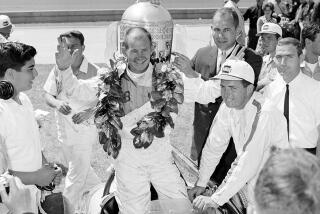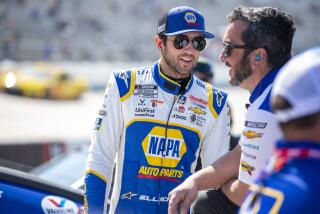Gentlemen, Start Your Simulators
- Share via
Francis De Giorgio wants to be a part of racing’s future. A sometime racer and full-time computer whiz, he and Erick Unbehand, both from Irvine, have essentially created a 75-pound joystick, the Virtual Vehicle simulator, that might help raise the speed bar and increase drivers’ skill.
Two years ago, they realized video technology that could create a realistic 3-D environment on a computer screen was on the horizon. They knew the software was already in place. The only thing left to create racing realism for the target group--race car drivers and high-end game players--was the input device. The result? Actual race tracks with realistic response from a vehicle that attaches to the joystick port of a home computer.
De Giorgio and Unbehand, partners at Irvine-based Interactive I/O, built the first Virtual Vehicle two years ago. The past eight months have been spent marketing the mock cockpit.
The steering wheel--a bona fide racing one--provides realistic dampened steering, giving the sensation of reacting to turns, the loss of traction, the loose rear end, just as a real car would.
“The mind fills in the blanks,” De Giorgio said. “People get out of it and ask, ‘How did you get the seat to move?’
“It’s hard to turn the wheel at 160 mph. We want to simulate those forces.”
The Virtual Vehicle has authentic aluminum pedals and seat within a two-foot by four-foot steel chassis. Modifications--some professional drivers have requested their own steering wheels be mounted--are not a problem. ComputerLife magazine gave it five stars and called it “the ultimate racing simulation machine.”
The computer monitor rests on the steering wheel base. When used with enhanced Rendition-ready software from any computer store (IndyCar Racing II, Grand Prix II, NASCAR II, The Need for Speed, Monster Trucks, Whiplash) and one of three available Rendition video cards for a home PC (Total 3D, Screamin’ 3D, and Reactor), it is astonishingly realistic.
Eventually, there might be more to what De Giorgio calls “force feedback”--where the cockpit rocks upon colliding with a wall or car, or the steering wheel jerks when hitting a curb or the driver experiences simulated G-force.
The vehicles will be used in NASCAR Cafes and possibly modem leagues on the World Wide Web. Prices range from $495 for a desktop model, which includes steering wheel and pedals but no seat, to $3,250 for a complete system that includes the chassis, a computer and a 17-inch monitor.
De Giorgio and Unbehand are currently creating a flightstick package for flight simulators.
Indy car racer Bryan Herta, who will receive his vehicle next week, already is trying to push the envelope in a virtual world while knowing quite well what it’s like in the real one. The course record-holder at the one-mile Phoenix speedway (181.954 miles per hour), Herta took Papyrus’ IndyCar Racing II game software, made adjustments in the car and inched his way past 184.2 mph at a time.
“It’s not to the point where if I put two degrees more on the front wing in the game it will also go faster in the car,” Herta said. “It’s not that direct.”
But it’s headed in that direction. Someday, Pi Research racing information--the diagnostics from an actual car speeding around a track--will be downloaded into a computer hooked up to a virtual vehicle. From there, a team can make adjustments in the computer and see how the real car will react before ever picking up a wrench.
It’s down the road, but it’s coming.
Herta, who attended UC Irvine for three years and finished eighth in last year’s PPG Cup points standings, says the Virtual Vehicle might have tangible benefits right now.
“I take the approach that it just can’t hurt,” said Herta, who drives for Team Rahal. “I’m not going to say you’ll go out and win a race because you drive this machine. The realism is getting to a level that it becomes applicable. You can run laps on a track in this machine and it will help you re-familiarize yourself with a circuit, your hand-eye coordination, timing.
“To me, it’s the feel of the brake pedal, the amount of pedal pressure it takes, the feel of the throttle and how much weight is in the steering wheel. Maybe I have a different perspective on it, because not everyone knows what it’s like to drive an Indy car and can’t make that comparison. But it makes the whole package complete. That’s as close as you can get right now.”
De Giorgio, who has his SCCA license, says it already has helped his own Showroom Stock racing. He improved his time at Holtville by three seconds from the previous year in the exact same car.
His practice? He drove the Virtual Vehicle while showing it at trade shows, and while traveling the IndyCar circuit, entertaining at media and sponsor events on race weekends.
Paul Jasper, rookie of the year for SCCA Player’s/Toyota Atlantic Series, improved his qualifying time at Laguna Seca last year after a two-hour cram session inside the Virtual Vehicle.
Max Papis, who drives for Arciero-Wells, spent 30 minutes on the Virtual Vehicle at Laguna Seca. But, he said, the Virtual Vehicle isn’t complete--yet.
“It’s like driving a car without the extreme environment,” he said.
Crashing on a computer screen, after all, is a lot less costly than crashing on the track.
“It’s a game. It’s not racing,” Herta said. “It’s not IndyCar. It’s entertainment, and it’s really good at that.”
Said De Giorgio: “The big difference between this and real racing is that in real racing, you can die.”
To find out more about the Virtual Vehicle, call (714) 921-0994, or visit the Web site at https://www.interactiveio.com
*
Because of stadium renovation, the 1997 AMA Supercross Series won’t be in Anaheim, where a decade-high 65,264 watched last year. However, it will play consecutive weekends at the L.A. Coliseum, Jan. 11 and 18, kick-starting the series.
Jeremy McGrath won 14 of 15 races last year, but Riverside’s Jeff Emig--who rides for Irvine-based Kawasaki and finished second last season--thinks that story line could change.
For one, Emig, the only person to beat McGrath in a 1996 series race, believes he can win.
“My confidence level in Supercross is up, and I feel I’m strong enough right now to win no matter what Jeremy does,” Emig said. “I’m just riding better. Last year was my first year with Team Kawasaki. I wasn’t real comfortable on the motorcycle, but I am now. I don’t want to take anything away from Jeremy, but I feel I’m strong enough to win.”
Besides, it might be good for the sport to have someone besides McGrath win week after week.
“There are a lot of us, not just McGrath, who are going fast this year,” said Emig, who won the AMA 250cc National Championship Series. “If they take one win, then two wins, it just snowballs. There are a couple guys on each team who could break out and win a lot of races. You can’t just focus on beating McGrath, [although] last year, it was that way because he won every race but one.”
*
Arciero-Wells’ new 1997 Reynard chassis arrived Jan. 3 from Bicester, England. It is the first of four on order. The Santa Margarita-based team will have a shakedown test at Buttonwillow later this month, before spring training for Indy cars begins Jan. 30-Feb. 1 in Homestead, Fla., site of the first race of the PPG CART World Series season, the Marlboro Grand Prix of Miami.
More to Read
Go beyond the scoreboard
Get the latest on L.A.'s teams in the daily Sports Report newsletter.
You may occasionally receive promotional content from the Los Angeles Times.










